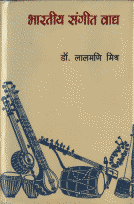Excerpts from
Bharatiya Sangeet Vadya - Sitar Blemishes | |
By Dr. Lalmani Misra |
|
{ This brief note, taken from chapter on modern instruments (Bharatiya Sangeet Vadya Bharatiya Jnanpith, New Delhi, 1973. Second edition, 2002. pp 289 - 90 ) helps in clarifying doubts and selecting a well-made Sitar. }
Blemishes in Sitar

1. Displacement or Flattening of Tabli (head-board):
It has been described earlier how Tabli is raised in center, especially near the area of placement of bridge. If the inner part of Tabli is thin and Sitar strings are tuned in notes higher than necessary, then the pressurised by these strings, the Tabli bends inwards and loses its convexity. This flattening of Tabli is referred to as “Tabli baith jana”. Flattened Tabli reduces resonance of Sitar and has to be changed for it be of use to discerning artistes.
2. Bending of Dand (Stem/ finger-board):
Tuning Sitar strings in notes higher than necessary, often results in upward bending of Stem. If the timber used in Dand was not seasoned and aged or the joint between Tumba and Dand was not sufficiently strong, it would yield to pressure of strings pulling it upwards. This increases the distance between frets and the strings. This flaw can be rectified if caused by imperfect joint, but in case the stem itself bends, a fresh Dand is required.
3. Loss of Jawari:
Due to constant vibrations, strings passing over the bridge make grooves and inflexions. Thus, the initial balance of strings obtained at time of Jawari is lost and natural resonance of Sitar gets reduced. This phenomena is referred to as “Jawari band ho jana” or dying/ closing of Jawari. Reduction in resonance may arise from flattening of Tabli, bending of Dand, change in alignment of bridge or grease on point of Jawari. A master craftsman would remove these flaws and restore its original sound to Sitar. (Jawari is method of manipulating the bridge by rubbing, scrubbing or grazing, or attaching thin pieces of wool or silk, to achieve adequate distancing of string from the end of bridge. This improves the tonal quality by providing room to string for greater resonance. Open Jawari allows greater resonance while closed Jawari dulls the sound.)
4. Tightening of Baj string results in slackening of others:
Generally this flaw is present in almost all Sitar-s to some extent. At the moment Baj string is pulled along the fret, on testing it would be found that Jodi, Ati-Mandra-Pancham and Ati-Mandra-Shadja strings have been displaced from their original places, but soon as Baj string returns to its original position, the other strings also regain theirs*. Two prime causes of this defect are the joint between Dand and Tumba and use of defective wood in making of Dand. Once the Sitar is finished, this flaw cannot be removed. To keep this flaw from developing only the Chikari strings are strummed along with Baj string. Pulling of Baj string has no effect on Chikari strings as they are fixed on independent spikes (Papiha).
5. Disturbance caused by uneven Frets:
“Pardon ka Ladanaa” is how the unnecessary touching of string with next fret, as it is being pressed or pulled along one, is referred to as another minor flaw of Sitar. This is caused by deviation of fret from its required position. It is easily re-adjusted by master craftsman.
6. Bending of Khunti (Peg):
String-pressure or defect in wood may cause the Khunti to lose its sustaining capability. It may either loose tension or get too tight to move. The peg needs to be replaced.
* Because the strings share same axis at main end of ghudach, theoretically, the stationary strings shall try to achieve same level of vibration as the Baj one. Accomplished artistes take care to avoid strumming Jodi, Ati-Mandra-Pancham and Ati-Mandra-Shadja strings while playing or pulling on Baj. They play on Chikari strings situated on independent spikes, instead.The strong Shadja, Pancham poduced, balance the Baj deviation and pull everything towards the normal range of vibration. Not only does this practice minimize existing flaw, if any; it reduces the chances of its development.

References :
Sitar (full article)
Bharatiya Sangeet Vadya published by
Bharatiya Jnanpith
18, Institutional Area, Lodhi Rd
New Delhi - 110003
Bharatiya Shastriya Sangeet: Shikshan, Shastra Va Prayog.
Back to Articles



